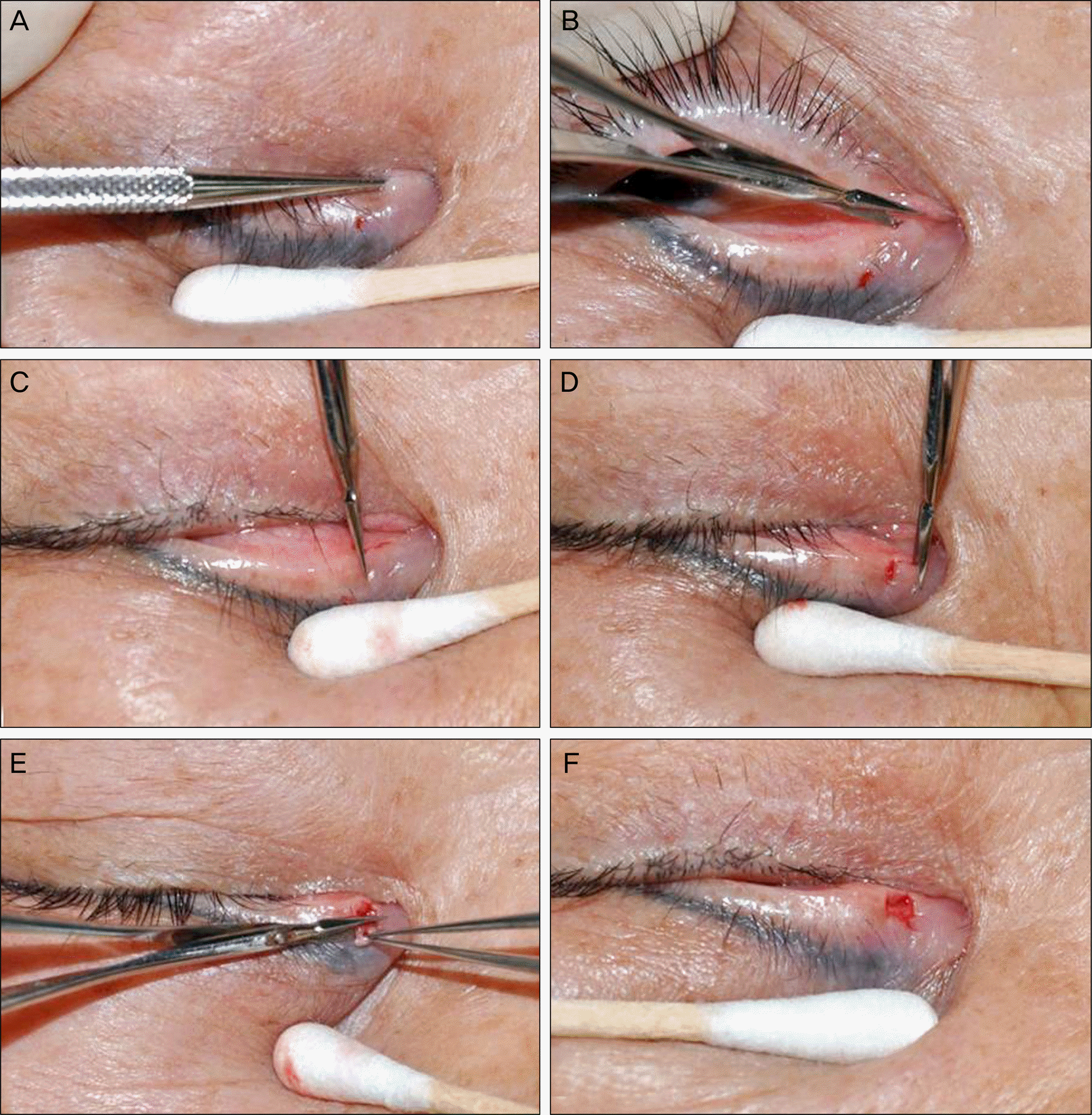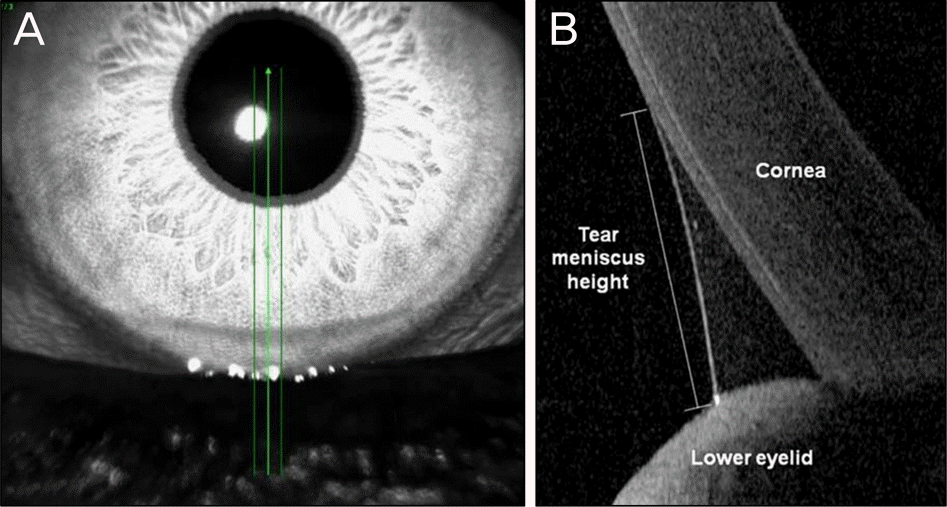Abstract
Purpose
To evaluate the efficacy of anterior-side rectangular 4-snip punctoplasty, a modification of posterior ampullec-tomy that is currently used in patients with punctal stenosis.
Methods
We performed a retrospective chart review of patients with punctal stenosis who underwent anterior-side rectangular 4-snip punctoplasty at our hospital. Fluorescein dye disappearance test (FDT) and questionnaire on tearing symptoms and tear meniscus height (TMH) based on spectral-domain optical coherence tomography (SD-OCT) were evaluated in preoperative and postoperative follow-up examinations of the patients. Anatomical success was defined as punctum without re-stenosis at last visit; functional success was defined as FDT grade of 0 or 1, or tearing symptom score of 2 or less.
Results
A total of 44 anterior-side 4-snip punctoplasty procedures were performed in 27 patients. The average age of all subjects was 56.0 ± 11.0 years (range, 39 to 82 years). The mean follow-up period was 9.4 months (range, 6 to 20 months). FDT, tearing symptom score (p < 0.01, Wilcoxon signed-rank test), and TMH (p < 0.01, paired t-test) were significantly decreased after surgery. Anatomical success was 40/44 cases (90.9%) and functional success was 38/44 cases (86.4%). There were no complications such as skin defect or cosmetic problems.
Go to : 
References
1. Bowman W. Methode de traitment applicable a l'epiphora dependent du renversement en dehors ou de l'obliteration des points lacrymaux. Ann Oculist. 1853; 29:52–5.
2. Jones LT. The cure of epiphora due to canalicular disorders, trauma and surgical failures on the lacrimal passages. Trans Am Acad Ophthalmol Otolaryngol. 1962; 66:506–24.
4. Thomas JB. A modification of Graves' operation for epiphora due to stenosis of the lacrimal punctum. Br J Ophthalmol. 1951; 35:306.

5. Viers ER. Disorders of the canaliculus in the lacrimal system. New York: Grune and Stratton;1955. p. 46–7.
6. Caesar RH, McNab AA. A brief history of punctoplasty: the 3-snip revisited. Eye (Lond). 2005; 19:16–8.

7. Shahid H, Sandhu A, Keenan T, Pearson A. Factors affecting out-come of punctoplasty surgery: a review of 205 cases. Br J Ophthalmol. 2008; 92:1689–92.

8. Chak M, Irvine F. Rectangular 3-snip punctoplasty outcomes: preservation of the lacrimal pump in punctoplasty surgery. Ophthal Plast Reconstr Surg. 2009; 25:134–5.

9. Kim SE, Lee SJ, Lee SY, Yoon JS. Outcomes of 4-snip puncto-plasty for severe punctal stenosis: measurement of tear meniscus height by optical coherence tomography. Am J Ophthalmol. 2012; 153:769–73.

10. Edelstein J, Reiss G. The wedge punctoplasty for treatment of punctal stenosis. Ophthalmic Surg. 1992; 23:818–21.

11. Offutt WN 4th, Cowen DE. Stenotic puncta: microsurgical punctoplasty. Ophthal Plast Reconstr Surg. 1993; 9:201–5.
13. Awan KJ. Laser punctoplasty for the treatment of punctal stenosis. Am J Ophthalmol. 1985; 100:341–2.

14. Kwon JK, Chang MW, Baek SH, Lee TS. Punctoplasty using a ra-diofrequency surgical unit for punctal stenosis. J Korean Ophthalmol Soc. 2012; 53:1727–31.

15. Kristan RW. Treatment of lacrimal punctal stenosis with a onesnip canaliculotomy and temporary punctal plugs. Arch Ophthalmol. 1988; 106:878–9.

16. Lam S, Tessler HH. Mitomycin as adjunct therapy in correcting iatrogenic punctal stenosis. Ophthalmic Surg. 1993; 24:123–4.

17. Ma'luf RN, Hamush NG, Awwad ST, Noureddin BN. Mitomycin C as adjunct therapy in correcting punctal stenosis. Ophthal Plast Reconstr Surg. 2002; 18:285–8.
18. Kwak JY, Chang HK. Silicone intubation for treatment of punctal stenosis. J Korean Ophthalmol Soc. 2003; 44:2451–6.
19. Koh HG, La TY. Punctoplasty using cut down tube. J Korean Ophthalmol Soc. 2004; 45:546–51.
20. Kashkouli MB, Beigi B, Astbury N. Acquired external punctal stenosis: surgical management and long-term follow-up. Orbit. 2005; 24:73–8.

21. Roh JH, Chi MJ. Efficacy of dye disappearance test and tear me-niscus height in diagnosis and postoperative assessment of nasola-crimal duct obstruction. Acta Ophthalmol. 2010; 88:e73–7.

22. Carter KD, Nelson CC, Martonyi CL. Size variation of the lacrimal punctum in adults. Ophthal Plast Reconstr Surg. 1988; 4:231–3.

23. Yoon KC, Jeong SK, Park YG. Study of iacrimal punctal size in normal adults. J Korean Ophthalmol Soc. 1997; 38:1916–20.
24. Olver J. Canalicular surgery. Colour atlas of lacrimal surgery. Chapter 6. Oxford: Butterworth-Heinemann;2002.
25. Zappia RJ, Milder B. Lacrimal drainage function. 2. The fluo-rescein dye disappearance test. Am J Ophthalmol. 1972; 74:160–2.
26. MacEwen CJ, Young JD. The fluorescein disappearance test (FDT): an evaluation of its use in infants. J Pediatr Ophthalmol Strabismus. 1991; 28:302–5.

27. Santodomingo-Rubido J, Wolffsohn JS, Gilmartin B. Comparison between graticule and image capture assessment of lower tear film meniscus height. Cont Lens Anterior Eye. 2006; 29:169–73.

28. Oguz H, Yokoi N, Kinoshita S. The height and radius of the tear meniscus and methods for examining these parameters. Cornea. 2000; 19:497–500.

29. Francis IC, Chan DG, Papalkar D. . Videoreflective dacryomeniscometry in normal adults and in patients with functional or pri-mary acquired nasolacrimal duct obstruction. Am J Ophthalmol. 2005; 139:493–7.

Go to : 
 | Figure 1.Surgical procedures of the anterior-side 4-snip punctoplasty. (A) The punctum is dilated with a punctal dilator. (B) The first, horizontal cut is made with a pair of Vanna’s scissors. (C, D) Two vertical cuts are made from the edge of the first horizontal cut. (E) Finally, the base of the flap is removed. (F) The dilated punctum is shown. |
 | Figure 2.Tear meniscus height by spectral-domain optical coherence tomography. (A) Three vertical scans passing cornea, tear meniscus and lower eyelid were performed at 6 o’clock position. (B) The tear meniscus height was measured with a caliper. |
 | Figure 3.Dye disappearance test, tearing symptom score and tear meniscus height were decreased significantly after surgery. (A) Dye disappearance test, (B) Tearing symptom score, (C) Tear meniscus height, * Wilcoxon signed-rank test; † paired t-test. |
 | Figure 4.(A) Preoperative stenotic punctum is shown. (B) Postoperative 6 months, dilated punctum was maintained. |
Table 1.
Questionnaire of tearing symptoms




 PDF
PDF ePub
ePub Citation
Citation Print
Print


 XML Download
XML Download